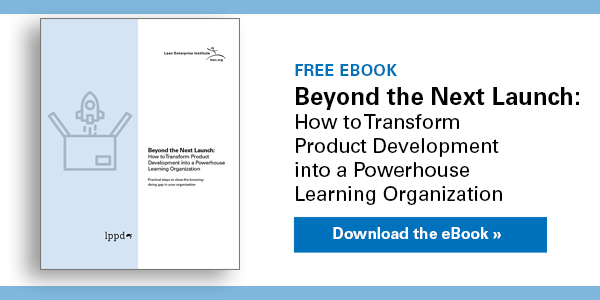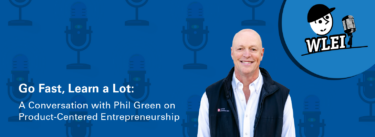Startups only thrive by delivering value through innovation. Whether it’s designing revolutionary medical devices, cutting-edge tech gadgets, sustainable consumer goods, or a new service, today’s entrepreneurs must have a deep understanding of user needs, market gaps, and the technical feasibility of their ideas. Creating these products of the future demands a mix of creativity, development expertise, and a relentless commitment to quality. Just think of companies like Apple, Tesla, Google, and Dyson. They revolutionized their industries by adhering to customer-focused innovation. While they have certainly made their share of mistakes, they got some pretty core things right.
As lean coaches who have primarily worked with large, established organizations, we see an enormous opportunity for entrepreneurs to build in lean product and process development (LPPD) thinking and practices from the start. This isn’t only the responsibility of product leaders or technical experts; this is the work of all leaders and founders, as well as the growing enterprise as a whole.
Why Lean Product and Process Development?
This is an excellent question to start with, as there are many different views as to what LPPD even is. In a few words, we view it as a holistic system of people, processes, and tools constantly aligning to develop successful value streams. For guidance, we refer to six guiding principles first proposed by Jim Morgan in September of 2020. This backdrop, coupled with our experience, leads us to suggest the following reasons for entrepreneurs to embrace LPPD:
Speed and Agility: Entrepreneurs often operate in dynamic markets where speed is critical. LPPD’s approach ensures that development cycles are swift and adaptable, while keeping key stakeholders aligned. By focusing on rapid learning and validating concepts early, entrepreneurs are able to pivot quickly and respond to changing demands.
Customer-Centric Innovation: Successful products resonate deeply with their target audience. LPPD enables entrepreneurs to create solutions tailored to real needs rather than hypothetical ones. When was the last time one of your favorite products was updated for you to only wonder, “Why did they do this?!”
Minimizing Waste: Startups and small enterprises often have limited resources. LPPD practices help reduce waste to ensure that every dollar, hour, and effort is directed toward value-added outcomes.
Scalability and Sustainability: As businesses grow, scalability becomes essential. LPPD facilitates this by fostering processes that are effective, efficient, and repeatable. Entrepreneurs can leverage these principles to expand their operations without compromising quality or performance.
Key LPPD Practices
For mature organizations and entrepreneurs alike, LPPD serves as a framework to ensure that innovation, value creation, resource allocation, time management, team collaboration, and continuous learning are aligned with the goal of customer satisfaction.
Customer Focus through a Concept Paper: A deep understanding of the customer is central to LPPD. To design in value into products, entrepreneurs can capitalize upfront in the study phase to understand the customer and support their teams in thoroughly exploring design space. This means leaders must engage directly with users at their gemba, gather feedback, and incorporate their insights into the product development process. Essentially, every organization is attempting to solve a problem for the customer. Understanding the situation is foundational to problem solving. The concept paper makes value visible and helps align and enroll the organization on the needs of the customer in conjunction with the needs of the business.
Where to start:
- Coach’s Corner: Understanding the Value of a Concept Paper
- The Concept Paper for a New Product: The Kickstart of a LPPD Project
Set-Based Concurrent Engineering: To ensure profitability for the company, you want to explore multiple alternatives early and generate what’s called “reusable knowledge” to effectively converge to the best solution that optimizes value for the customer.
Where to start:
Design the Value Stream in Conjunction with the Product: Designing a great product is a starting point, but creating successful value streams is necessary for the long-term viability of any enterprise. As an entrepreneur, you need to define success. The second “P” of LPPD (process) strives to ensure high quality, reliable delivery while designing out the waste upfront. Far too often, value streams are launched despite being hamstrung by myopic decisions made early in development. This typically results in a flurry of “engineering rework” often mistaken as kaizen. By co-creating the product and the value stream, you and your team can avoid this.
Where to start:
Cross-Functional Collaboration: A cohesive team comprising engineering, design, marketing, and manufacturing experts fosters synergies and ensures that all perspectives are considered in the development process. Building an obeya is a hugely effective way to create a home room for collaboration and cross-functional problem solving.
Where to start:
Knowledge-Based Decision-Making: This often includes things like decision flow mapping to identify key decisions and knowledge gaps and using rapid learning cycles to close those knowledge gaps to deliver value while minimizing risks to the organization. As an entrepreneur, the knowledge your start-up creates IS its competitive advantage. Think right decisions, right knowledge, right time with the right people.
Where to start:
- How to Improve Decision-Making to Accelerate Product Development
- Building in Learning and Knowledge Reuse
Why focus on LPPD when you’re just starting to build your company? Lean product and process development empowers entrepreneurs to holistically navigate the complexities of product creation with purpose and precision. By focusing on customer needs, this approach not only leads to groundbreaking products and services but also builds sustainable businesses. It sets you up for long-term profitability.
In an era where competition is fierce and resources are finite, engaging seriously with these ideas can be the key to entrepreneurial success. Tell us how it goes!
Download the latest edition of The Design Brief
Designing the Future
An Introduction to Lean Product and Process Development.









